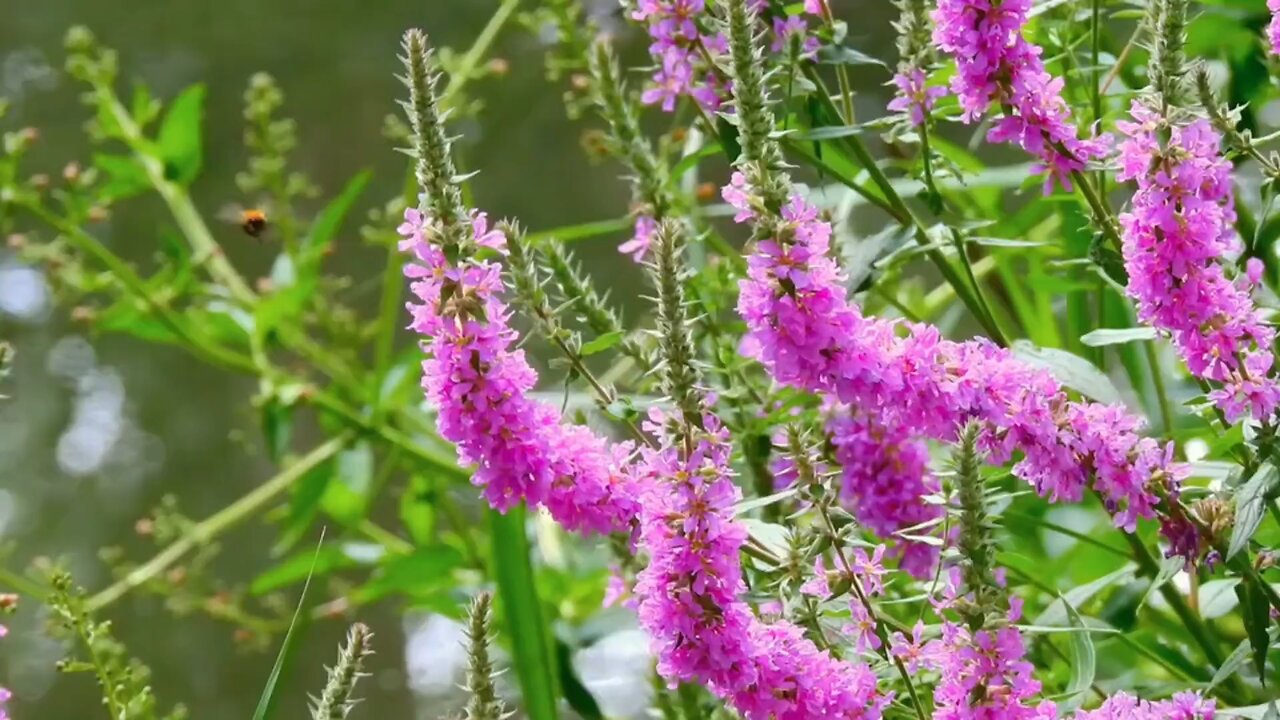Premium Only Content

"Purple Loosestrife: Nature's Splendor with a Dark Side"
*Lythrum salicaria*, commonly known as purple loosestrife, is a perennial herbaceous plant that belongs to the Lythraceae family. Here’s a detailed look at this plant:
### **Physical Characteristics:**
- **Height:** Purple loosestrife can grow to a height of 1 to 2 meters (3 to 6.5 feet).
- **Stems:** The plant has a square stem that can have multiple branches. The stem is covered with fine hairs, giving it a slightly rough texture.
- **Leaves:** The leaves are lance-shaped, opposite or in whorls of three, and are attached directly to the stem without a stalk. They are typically dark green and can be up to 10 cm long.
- **Flowers:** The flowers are its most distinctive feature. They are arranged in long, dense spikes at the top of the stems. Each flower has 5 to 7 petals, and their color ranges from pink to vibrant purple. The flowers bloom from mid to late summer, and each plant can produce millions of seeds during its lifetime.
- **Roots:** The plant has a robust, woody root system that helps it to spread quickly.
### **Habitat and Distribution:**
- *Lythrum salicaria* is native to Europe and Asia, where it typically grows in wetlands, marshes, riverbanks, and moist meadows. It was introduced to North America in the early 19th century, possibly as an ornamental plant or through ballast water from ships.
- In North America, purple loosestrife has become an invasive species, spreading rapidly in wetlands and outcompeting native plants. This can lead to a reduction in biodiversity and negatively impact wildlife habitats.
### **Ecological Impact:**
- As an invasive species, purple loosestrife can form dense stands that dominate wetland ecosystems. It displaces native plants that provide food and shelter for wildlife, especially waterfowl, amphibians, and insects. Its ability to produce a large number of seeds and its robust root system make it difficult to control once established.
### **Uses:**
- Despite its invasive nature in some regions, purple loosestrife has been used traditionally in herbal medicine. It was historically used to treat diarrhea, dysentery, and wounds. However, its use is less common today due to concerns about its invasive potential.
- In its native range, it is still admired for its beauty and is sometimes used in gardens, although care must be taken to prevent it from spreading.
### **Control and Management:**
- Controlling the spread of purple loosestrife is challenging. Methods include mechanical removal (pulling out the plants), chemical treatments (using herbicides), and biological control (introducing insects that feed on the plant, such as the Galerucella beetles).
- In many areas where it is invasive, efforts are ongoing to reduce its impact on natural ecosystems and to restore native plant species.
Purple loosestrife is a plant that exemplifies the delicate balance between beauty and ecological responsibility. While it adds stunning color to landscapes, it poses significant challenges in areas where it is not native.
-
 LIVE
LIVE
BlackDiamondGunsandGear
7 hours agoAFTER HOURS ARMORY w/ DLD & John from GOA & FLR
269 watching -
 1:05:28
1:05:28
Man in America
9 hours agoTREASON? Obama, Hillary, and Soros in the New World Order Agenda EXPOSED w/ Mel K
49.7K14 -
 LIVE
LIVE
The Connect: With Johnny Mitchell
9 hours ago $0.11 earnedOne Man's Mission To Stop Human Trafficking: How A Billionaire Mercenary Saved Hundreds Of Children
446 watching -
 LIVE
LIVE
Tundra Tactical
5 hours ago $0.07 earned🔫 California Ammo Win, Sig Sauer P320 Controversy, Meme Review & Would You Rather! 🎉🔥
465 watching -
 16:24
16:24
Forrest Galante
2 hours ago6 Deadliest Man Eaters to Ever Exist
9.68K2 -
 10:14
10:14
MattMorseTV
7 hours ago $0.34 earnedThe EU is in HOT WATER.
67.9K37 -
 LIVE
LIVE
The Rabble Wrangler
1 day agoPUBG with The Best in the West!
153 watching -
 3:57:19
3:57:19
EvilT4000
5 hours agoSaturday.....🟢For energy and focus click my Dubby link!
9.32K1 -
 LIVE
LIVE
SlingerGames
2 hours agoSpartan Night - Halo and More | Creator for @SELFMADEGGS
48 watching -
 3:57:49
3:57:49
Mally_Mouse
7 hours agoSpicy Saturday!! - 10k CELEBRATION! - Let's Play: Labyrinthine
25.2K1